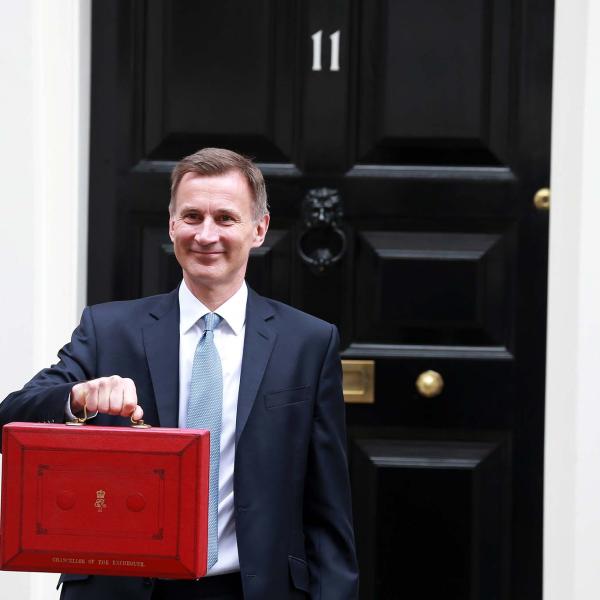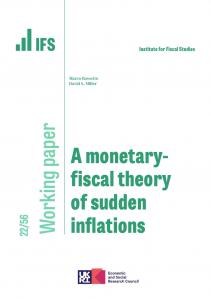The headline GERS figures
Today sees the now traditional annual debate on what the Scottish Government’s Government Expenditure and Revenue Scotland (GERS) statistics can or cannot tell us about the public finances of an independent Scotland. Up front it is therefore worthwhile highlighting that while like any statistics they are not perfect, their status as National Statistics means they have been independently assessed as being based on sound methods and being produced free from political interference.
The latest figures are attracting perhaps even more attention than usual because of the scale of borrowing they reveal – an estimated 22.4% of GDP in 2020-21, up from 8.8% in 2019-20. This reflects a cash increase in expenditure of 21%, a cash reduction in revenues of 5% and a fall in nominal GDP of 10% as a result of the COVID-19 pandemic and the measures implemented in response to it. The UK as a whole’s deficit also reached a peacetime record of 14.2% of GDP as cash expenditures increased by 24%, cash revenues fell by 4% and nominal GDP fell by 6%. And these figures do not yet account for the cost of writing off loans to businesses affected by the pandemic that won’t be repaid which the Office for Budget Responsibility forecasts could push the final UK-wide deficit figures up by around 1.3% of GDP.
Delving deeper into the figures
Accounting for these additional forecast costs would place Scotland’s deficit in the middle of the range we projected in April (22 – 25% of GDP).
Measured as a percentage of GDP, Scotland’s implicit deficit is estimated to have increased by somewhat more than that of the UK as a whole: 13.6 percentage points versus 11.6 percentage points. About half of this is due to the larger estimated fall in Scottish nominal GDP, much of which is driven by a 40% fall in the value of oil and gas output from the North Sea. But Scotland’s deficit is also estimated to have increased by a little more in cash-terms: by around £3,750 per person, compared to around £3,600 for the UK as a whole. In the grand scheme of things this is a small difference though, and such differences are well within the margin of error of GERS.
Government expenditure is estimated to have increased by £3,141 per person in cash-terms, compared to £3,066 across the UK as a whole. That the figures are so close is not that surprising given that a large proportion of the additional expenditure was subject to the Barnett formula which allocates Scotland a population-share as a matter of course. The pattern across service areas is also very similar, although increases in health and education spending are estimated to have been slightly lower and increases in enterprise and economic development and social protection spending slightly higher. This may reflect the fact that lower spending in certain areas of health services (such as test and trace and procurement of personal protective equipment) allowed the Scottish Government to allocate a little more to other priorities.
Government revenues are estimated to have fallen by £612 per person in cash-terms, compared to £519 across the UK as a whole. Over half of this (modest) difference can be explained by North Sea oil revenues, which fell by 35% (and now contribute less than 1% of Scottish revenues and less than 0.1% of UK revenues). Onshore tax performance was very similar, although income tax revenues performed a little worse than in the UK as a whole (continuing a trend seen in recent years), while revenues from Scotland’s Land Transactions Tax held up better than the equivalent Stamp Duty Land Tax, likely driven in part by the Scottish Government’s smaller temporary tax cut.
Turning to the future, as the economy recovers, temporary additional spending on support for public services and the economy winds down, and increases in corporation and income tax ramp up, both Scotland and the wider UK’s deficits will fall. However, our most recent medium-term projections based on the OBR’s March 2021 forecasts suggest Scotland could still be facing a deficit of around 9% of GDP in 2025-26 if revenues and spending follow wider-UK trends, by which time the UK’s deficit is forecast to fall to just under 3% of GDP.
What are the implications of these figures?
Under current constitutional arrangements the implicit budget deficits and surpluses for the nations and regions of the UK are subsumed within the deficit of the UK as a whole. The UK government manages the overall public finances on behalf of whole country, and in effect, transfers revenues from those areas with surpluses (or smaller deficits) to the areas with (bigger) deficits.
The fiscal transfers that Scotland receives are normal within a fiscal union. Indeed, as our analysis earlier this year showed, the fiscal transfers to Wales and Northern Ireland are much larger, and those to the north of England slightly larger than in Scotland’s case. However, such transfers would cease under independence or ‘full fiscal autonomy’. In that case, Scotland’s implicit deficit would become the responsibility of the newly independent (or fiscally autonomous) Scottish Government.
A structural deficit of the scale of Scotland’s would not be sustainable on an ongoing basis. It would need to be tackled by some combination of spending cuts and/or tax rises, in the absence of much stronger economic performance, which is unlikely. (Indeed, recent research suggests disruptions to and increases in the cost of trade would likely adversely affect the economy, at least in the short-to-medium term.) The SNP’s Sustainable Growth Commission was admirably upfront about the need for a fiscal adjustment post-independence, although its honesty did not extend to admitting that its proposed solution of holding down spending to 1% a year below economic growth would likely mean austerity for at least some public services.
But wait a minute. Hasn’t the massive borrowing carried out by the UK government and other high-income country governments during the COVID-19 pandemic, and at very low borrowing costs to boot, shown that an independent Scotland need not be concerned about running a large budget deficit? It’s not clear that it does.
First, there is a difference between a temporary surge in borrowing like the UK’s – especially at a time when the household sector is massively boosting its saving – and the large structural deficit that an independent Scotland would start life with. And the UK government has announced a package of tax rises and cuts to previous spending plans which amount to 1.8% of GDP a year by 2025-26 in an attempt to bring the deficit down over time – although the spending totals will almost certainly be revised up in this autumn’s Spending Review.
Second, nearly all of the extra borrowing by the UK government since the pandemic began has effectively been financed by the Bank of England creating additional reserves on which interest is paid at Bank Rate – i.e. currently just 0.1%, as it expanded its programme of ‘quantitative easing’ to boost liquidity and support the economy during the pandemic. The US Federal Reserve and European Central Bank have also carried out similar operations to support their economies. If an independent Scotland were to use the pound informally, as is current SNP policy for the short-term, such monetary financing would unlikely be available to it on the same terms. On the other hand, a separate Scottish currency, the SNP’s preferred option for the longer-term, could come under pressure if Scotland’s public finances were seen as unsustainable by the financial markets, pushing up the cost of any sterling-denominated debt obligations of the Scottish Government, households and businesses. Indeed, one of the six tests the SNP say will guide the decision of when to move to a separate Scottish currency is that the Scottish Government has a “sufficiently strong and credible fiscal position in relation to [its] budget deficit and overall debt level”. Action to reduce Scotland’s deficit is therefore a key part of plans for a new currency that further down the road would give Scotland greater fiscal flexibility.
None of this means that Scotland cannot afford to be independent, nor that there aren’t a range of opportunities for better policy to improve performance and better address Scottish needs and preferences. If such policies can be developed and implemented, this might in the longer-term allow more to be spent on public services and more to be kept in Scottish people’s pockets.
Of course, saying you are going to boost economic performance through better policy making is easier than designing and implementing the necessary policies. But whether such an outcome is likely – and the policies that could help achieve or end up hindering it – and the broader pros and cons of independence are all issues for reasonable debate, and reasonable disagreement. But what there should not be disagreement over is the fact that Scotland, like most of the UK outside of the South of England, currently has a significantly weaker fiscal position than the UK as a whole; and the starting point for an independent Scotland at any point in the next few years would therefore almost certainly be as a country with a sizeable structural deficit. While not perfect, the GERS statistics tell such a clear story that that debate shouldn’t currently be a debate at all.








